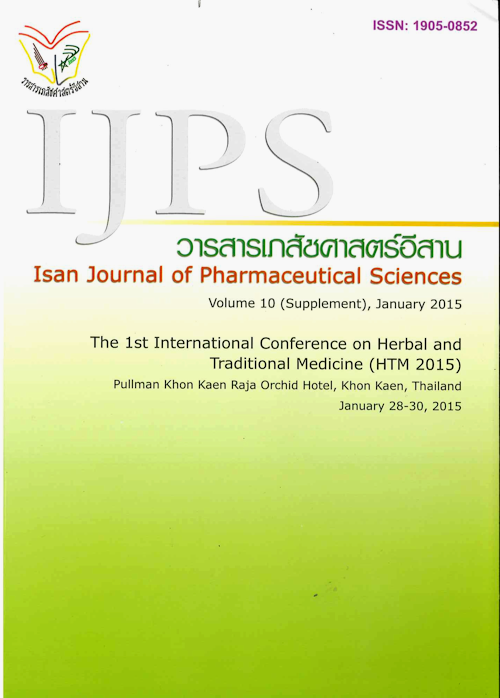Anti-anxiety Activity, Acute Toxicity and Cytotoxic Property of Extract of Clausena harmandiana (Pierre) Leaves
Main Article Content
Abstract
It is a state of excessive fear characterized by motor tension, sympathetic hyperactivity, apprehension
and vigilance syndromes. During this decade, anxiety affects one-eighth of the total population of the
world particularly in developed countries. Various types of herbal medicines have been used as
anxiolytic drugs in different parts of the world. The purpose of present study was to evaluate anxioly
tic effect of alcoholic extract of Clausena harmandiana (Pierre) leaves as well as its acute toxicity and
cytotoxicity. Methods: The anti-anxiety activity was determined by light-dark exploration method in
mice. Acute toxicity of C. harmandiana extract was evaluated in Wistar rats.The acute toxicity study
was carried based on OECD guideline 420 and fi xed dosage was adopted to 15,000 mg/kg. The MTT
assay was carried out to evaluate the cellular toxicity activity of C. harmandiana on TK6 (human
lymphoblasts), L929 (mouse fi broblasts) and Caco-2 (human colorectal adenocarcinoma cells). Results:
The signifi cant anti-anxiety activity of C. harmandiana extract was found when tested at 500 mg/kg.
The acute toxicity suggest the oral LD50 of C. harmandiana extract is greater than 15,000 mg/kg in rats
of both sexes. According to IC50 obtained from the MTT test, C. harmandiana extract was potentially
toxic to TK6 cells (IC50 = 29.98±4.52 μg/ml) and potentially harmful to L929 (IC50 = 679.23±35.04 μg/
ml) and Caco-2 (IC50 = 537.65±11.89 μg/ml) cells. Conclusion: Regarding results on light-dark task
and acute oral toxicity tests performed in animals, it can be summarized that C. harmandiana extract
possesses anti-anxiety property and it is safe to use. Cytotoxicity test indicates greater sensitivity of
C. harmandiana extract to cancer cells (Coco-2) than to normal cells (L929).
Article Details
In the case that some parts are used by others The author must Confirm that obtaining permission to use some of the original authors. And must attach evidence That the permission has been included
References
Ardayfi o P, and Kim KS. Anxiogenic-like effect of chronic corticosterone in the light-dark emergence task in mice. Behavioral Neuroscience 2006; 120: 249-259.
Berridge MV, Herst PM, Tan AS. Tetrazolium dyes as tools in cell biology: New insights into their cellular reduction. Biotechnology Annual Review. 2005; 11: 127-49.
Cesar AB, Marina P, Juliano A, Roehrs, Cristina W, Gilson Z, Involvement of serotonergic system in the anxiolytic effect caused by m-trifl uoromethyldiphenyl diselenide in mice, Behav Brain Res 2009; 205, 511-517.
Chaichantipyuth C, Pummangura S, Naowsaran K, Thanyavuthi D, Anderson JE, Mclaughlin JL. Two new bioactive carbazole alkaloids from the root bark of Clausena harmandiana. J Nat Prod 1988; 51(6): 1285-1288.
Gad Shayne. Alternatives to in vivo studies in toxicology. In B. Ballantyne, T. C. Marrs & T. L. M. Syversen (Eds.), General and applied toxicology (Vol. 1, pp. 178). London; New York, NY: Macmillan; Grove’s Dictionaries.
Hyun-Sook Y, Seok-Yong L, Choon-Gon J, Involvement of 5HT1A and GABA A receptors in the anxiolytic like effects of Cinnamomum cassia in mice, Pharmacol Biochem and Behav, 2008; 87, 164-170.
Krishna HNG, Sangha RB, Mirsa N, Pai MRSM. Antianxiety activity of NR-ANX-C, a polyherbal preparation in rats. Indian J Pharmacol 2006; 38: 330-335.
OECD Guidelines for the Testing of Chemicals, Section 4, Health Effect. Test number 420; Acute Oral Toxicity–Fixed Dose Procedure. 2001.
Songsiang U, Thongthoom T, Boonyarat C,Yenjai C, Claurailas A-D cytotoxic carbazolealkaloids from roots of Clausena harman-diana. J Nat Prod 2011; 74(2): 208-212.
Yenjai C, Sripontan S, Sriprajan P, Jintasirikul A, Tanticharoen M, et al. Coumarins and carbazoles with antiplasmodial activity from Clausena harmandiana. J Nat Prod 2000; 66(3): 277-279.
Wangboonskul JD, Pummangura S, Chaichanti-pyuth C. Five caumarins and a carbazole alkaloid from the root bark of Clausena harmandiana. J Nat Prod 1984; 47(6): 1058-1059.
Ozdemir KG, Yilmaz H, Yılmaz S. In Vitro Evaluation of Cytotoxicity of Soft LiningMaterials on L929 Cells by MTT Assay. Journal of Biomedical Materials Research. 2009; 90(1): 82-6.


